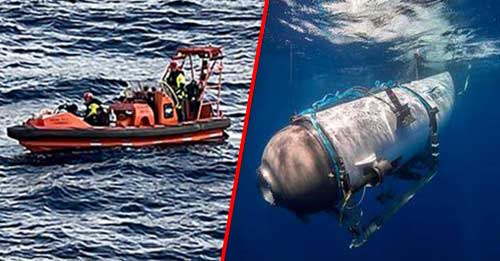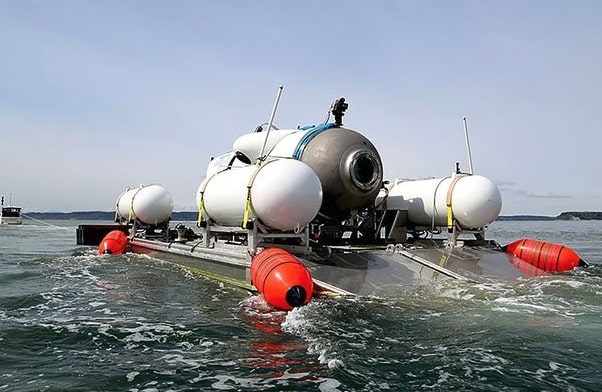On June 18, a submersible carrying five individuals went missing while exploring the Titanic. Here’s all you need to know about the search expedition.
What exactly is Titan? The US-based company OceanGate operates Titan, a submersible vessel that transports customers who have paid $250,000 as part of an eight-day excursion to examine the Titanic wreck, which is located about 350 miles off the coast of Newfoundland, Canada.
Titan requires guidance from a ship on the surface because, unlike a submarine, it cannot leave and return to port on its own. Passengers are confined inside the ship by bolts that are fastened from the outside.
When did it vanish? Titan started off on its journey on Sunday, June 18, but lost communication with its mothership after roughly 45 minutes.
The craft usually takes around two hours to reach the Titanic debris, indicating that it was probably nearing its objective when it lost touch with the mothership.
Who has agreed to participate? Titan is reported to have five people on board, including Stockton Rush, the CEO of OceanGate.
Shahzada Dawood, 48, and his son Suleman, 19, are the other passengers. Shahzada is a British-Pakistani businessman and the vice-chairman of Pakistan’s Engro Corporation.
Former French naval captain Paul-Henri Nargeolet, who served for 25 years. Nargeolet has conducted many missions to the Titanic disaster, where he oversaw the recovery of artifacts.
Hamish Harding, a British businessman and pilot, is the chairman of Action Aviation, which oversees private jet transactions.
Who is taking part in the rescue mission? The US Coast Guard’s Rear Admiral John Mauger is leading the urgent search and rescue effort with the clock ticking.
Officials are trying everything possible to return the five passengers home, according to Mauger, who said that as long as there is a chance of survival, they will continue to work with this broad unified command to bring every resource to bear on the search. Over the next 24 hours, they will have additional vessels and remotely operated vehicles, and they will continue to fly in the area. They’ll keep looking.
The search involves both Canadian and American ships and aircraft, including the Polar Prince, which deployed the Titan submarine, a pipe-laying vessel dubbed Deep Energy, and three additional Canadian vessels.
Where is the search being conducted? Aircraft have flown over an area ‘approximately the size of Connecticut’ off the coast of Newfoundland in search of clues that the vessel has surfaced.
On Wednesday morning, Canadian aircraft detected ‘underwater sounds’ in the region, but the ongoing search has returned ‘no findings’ so far.
They’ve picked up noise signatures and are working through the analytics of that, Mauger said in an update.
Titan is thought to have sunk 12,500 feet below the water’s surface, making the search very challenging and the operation one of the deepest ocean rescue operations in history.
What kind of equipment is being used? High water pressure and limited vision make the rescue effort difficult because Titan is believed to have fallen so far into the ocean.
Rescue crews have sent in a variety of equipment to help with the search, including long-distance reconnaissance planes capable of conducting radar and optical searches from above.
Sonar guys and a sonar ship have been put in the ocean to look for traces of the Titan.
According to Mauger, the sonar equipment can listen to a depth of 13,000 feet, although the Titanic debris that is believed to be in the region may make sonar identification difficult.
The following ships are engaged in the mission:
The Canadian CGS John Cabot, which has sonar capabilities.
The Canadian CGS Ann Harvey is equipped with both communication and navigational equipment.
The Atalante, a French research vessel capable of reaching the depths of the Titanic’s wreckage.
Glace Bay, His Majesty’s Canadian Ship, is capable of search and rescue operations.
If the vessel is discovered at such a considerable depth, rescuers will have to depend on a vehicle that can endure ocean pressure to reach it.
Teams have brought in the Victor 6000, a French underwater vehicle capable of descending to a depth of around 13,100 feet.
The Victor 6000 will be used to hunt for Titan and eliminate any impediments that may be stopping it from floating to the ocean’s surface.
How much time do you have left? Rescuers are running out of time to save all on board alive as the search effort enters its fourth night.
According to OceanGate data, Mauger estimates Titan had around 96 hours of oxygen on board when it went missing.
However, Mauger emphasized that the rate at which passengers use oxygen determines how long it will take to rescue them.
One of the factors that makes predicting how much oxygen is left difficult is that they don’t know the rate of oxygen consumption per occupant on the sub, he stated.
Mauger stated shortly before noon EST on Wednesday that the crew was working on the premise that they had roughly 20 hours to discover the sub.
- Will Smith Revels in Jada Pinkett Smith’s Bestselling Book: ‘Congrats, Mama!’Will Smith is pleased with his wife Jada Pinkett Smith’s […] More
- Paris Hilton Opens Up About Her Emotional Distress Following Hurtful Comments Regarding Her Son’s HeadParis Hilton has expressed her sadness regarding the response to […] More
- Will Smith describes his marriage to Jada as a “sloppy public experiment in unconditional love” during a book talkWill Smith made a public appearance alongside his wife, Jada […] More











